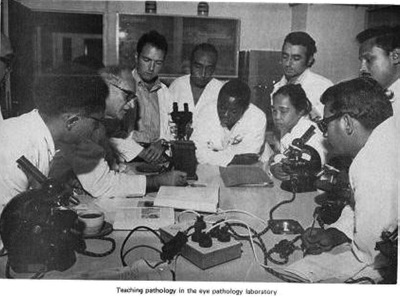

The centennial anniversary of the Hadassah Medical Organization’s Department of Ophthalmology is celebrated in the May issue of the American Journal of Ophthalmology, with an article by the immediate past director, Prof. Jacob Pe’er, and the current director, Prof. Itay Chowers.
In their extensive review of the history of Hadassah’s contribution to eye health in pre-state Israel, the authors explain how Henrietta Szold, during her 1908 visit, was so troubled by the flies in the eyes of countless children, that she vowed to tackle the problem. The medical missions she orchestrated, they report, led to the establishment of Hadassah, the Women’s Zionist Organization of America, with Ms. Szold as its founder.
At the same time, the Hadassah physicians describe the beginnings of ophthalmology under the Ottoman Empire in 1882 when Sultan Abdul Hamid II issued permission to the British to establish an eye hospital in Jerusalem–The St. John Eye Hospital of Bethlehem. Today that hospital services the Palestinian populations of East Jerusalem, the West Bank, and the Gaza Strip.
The history of Hadassah’s outreach to developing nations is also highlighted in depth, from its beginnings in 1959, when Hadassah Physician Prof. Michaelson “recognized the severe need of some African countries for a professional ophthalmologic workforce.” As they relate:
“In conjunction with the Israeli Ministry of Foreign Affairs, a decision was forged to export physicians so that African countries might establish departments of ophthalmology. Hadassah ophthalmologists opened or reopened 10 eye departments in Africa. The first one was in Monrovia, Liberia, followed by departments in Dar es Salaam, Tanzania; Blantyre and Lilongwe, Malawi; Kigali and Butare, Rwanda; Addis Ababa, Ethiopia; Maseru, Lesotho; Mbabane, Swaziland; and Nakuru, Kenya. It was a requirement for each Hadassah resident to commit to serving in Africa for at least two years as a precondition to acceptance into the residency program.”
The authors report also that 48 ophthalmologists from Hadassah have each spent two to four years in Africa. They have examined more than one million outpatients and performed about 200,000 vision-saving operations.
To enjoy the full article as it traces Hadassah’s pivotal contributions to ophthalmology, both in Israel and around the globe, see the Centennial Anniversary of the Department of Opthamology.
